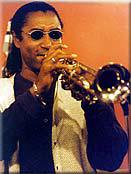
|
Michael „Patches" Stewart Chapter 1: New Orleans - the Birthplace of Jazz If you have heard Patches play, it will come as no surprise to learn that he was born and raised in the city where Jazz was born. He fell in love with the trumpet at a very young age but had to wait until he was in grade school to begin studying the instrument. While in junior high, he caught the attention of the music director at St. Augustine High School, a New Orleans institution with a sterling reputation for the consistent high quality of it's school band. Patches was awarded a full scholarship. Undeniably talented, his dedication to mastering the instrument, led him to seek additional opportunities to hone his skills outside of high school. He took supplemental music lessons at a local college and even managed to collect some tips from Ellis Marsalis. Naturally, he joined local bands that played school dances and small clubs; even "going on the road" for a few short tours during summer vacations. Patches' reputation around town grew and at the age of 16 he was called to a recording studio for the first time-he was part of the horn section on what was to become LaBelle's international hit "Lady Marmalade". Chapter 2: The Crossroads By the end of his senior year at St. Augustine's, Patches received scholarship offers from prestigious institutions, including the Berklee College of Music. Focused on a desire to perform, he headed for Los Angeles instead. After a few lean years working with local bands, his luck changed and he was asked to play and tour with the Brothers Johnson. After one performance, Patches met Quincy Jones, who incidentally started out as a trumpet player. Later on, Quincy included Patches in the band for his "The Dude" tour. Chapter 3: It's Getting Better All the Time In 1983 Patches began touring with another jazz giant-Al Jarreau. Al's frequent world tours introduced Patches to international audiences throughout Europe, North and South America, Australia and Japan. In between tours with Al, Patches found himself in demand for various studio recording sessions and performances with artists like David Sanborn, Anita Baker, George Duke, Bonnie Raitt, Rickey Lee Jones and Soul II Soul, but Jarreau was his "main gig" until 1991. Coincidentally, it was around that time that Marcus Miller, the Grammy winning producer, composer and "bass legend" responsible for writing hit songs for luminaries such as Miles Davis ("Tutu"), David Sanborn, Luther Vandross, Joe Sample and Al Jarreau, refocused his attention on his own projects. Since then, Patches has joined Miller in the studio and on tours. Miller's reputation for showcasing the talents of his "best of the best" band of musicians has led to Patches winning new fans in the USA, Europe and Japan. While performing with Miller in Europe, Patches met Executive Producer Massimo Gardel, who approached him about the possibility of recording a solo CD. The result of that collaboration was "Blue Patches", released in May 1997. The debut featured straight-ahead acoustic standards and was well received by jazz stations across the US; riding the Gavin Jazz Chart through the summer of 1997. Jazziz favorably reviewed Blue Patches and Jazz Times included a feature on Patches in the September 1997 issue. Chapter 4: More to Come In 1998, Patches followup CD "Penetration", was released in the US, Europe and Japan. He continues to record and tour with Marcus Miller. When he's not out with Marcus, Patches "keeps his chops up" with session work or appearing with other acts-for instance, you may have noticed Patches in Whitney Houston's horn section in her HBO concert special "Whitney, The Concert for a New South Africa" and on her last two Grammy Awards Show performances. |
|
Gallery |
